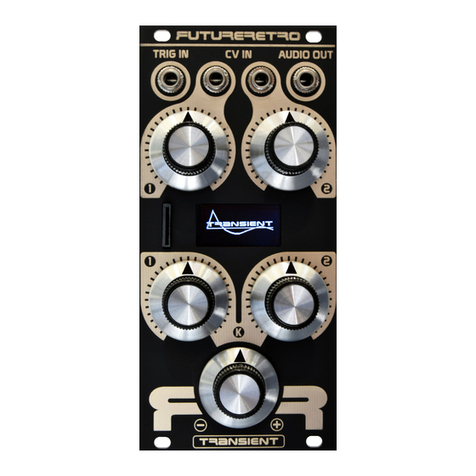
Variable release time
You can adjust the time it takes for the gate signal to decay once a notes gate signal is
turned off by increasing the resistance of resistor R175 (10K). For adjustable release
times, lift one end of R175 and run a wire from the lifted end of R175 to one of the outer
terminals of a potentiometer. Run another wire from the hole which R175 went to, to the
other outer terminal of the potentiometer. Connect the wiper of the potentiometer to one
of its outer terminals so that the resistance of the pot increases as you turn the
potentiometer clockwise. Note that more resistance creates longer release times. Again, I
would recommend using a 50K or 100K potentiometer for this mod, but feel free to
experiment.
This is a pseudo ASR type envelope in that the sustain portion is not adjustable in
amplitude. With less extreme settings for the attack and decay time you can eliminate
"popping" in the VCA and still retain the normal gate signal.
Increasing the overall amount all modifiers have on the filter’s cutoff frequency
For those of you who want some truly bizarre filter effects try this one.
By increasing the resistance of resistor R128 you will increase the range of each one of
the filter’s modifiers (Ie. CV/Warp, Osc B amount, Envelope amount). Lift one end of
R128 (2.2K) and run a wire from the lifted end of R128 to one of the outer terminals of a
potentiometer. Run another wire from the hole which R128 went to, to the other outer
terminal of the potentiometer. Connect the wiper of the potentiometer to one of its outer
terminals so that the resistance of the pot increases as you turn the potentiometer
clockwise. Note that more resistance results in more affect the modifiers will have on the
filter’s cutoff frequency. Try using a 50K potentiometer for this mod, and again
experiment.
Additional information
Filter cutoff frequency adjustment
It is not recommended to adjust the internal trim pots in the 777, unless you are retuning
the instrument.
There is one trim pot users can adjust to their liking. It is to control the range the cutoff
knob has on the filter’s cutoff frequency. You can find the trim pot just to the left of the
filter’s cutoff potentiometer. By rotating the trimmer clockwise you will allow for higher
frequencies in the filter’s cutoff setting. By turning the trimmer counter-clockwise you
will reduce the higher frequencies in the filter’s cutoff frequency range.































